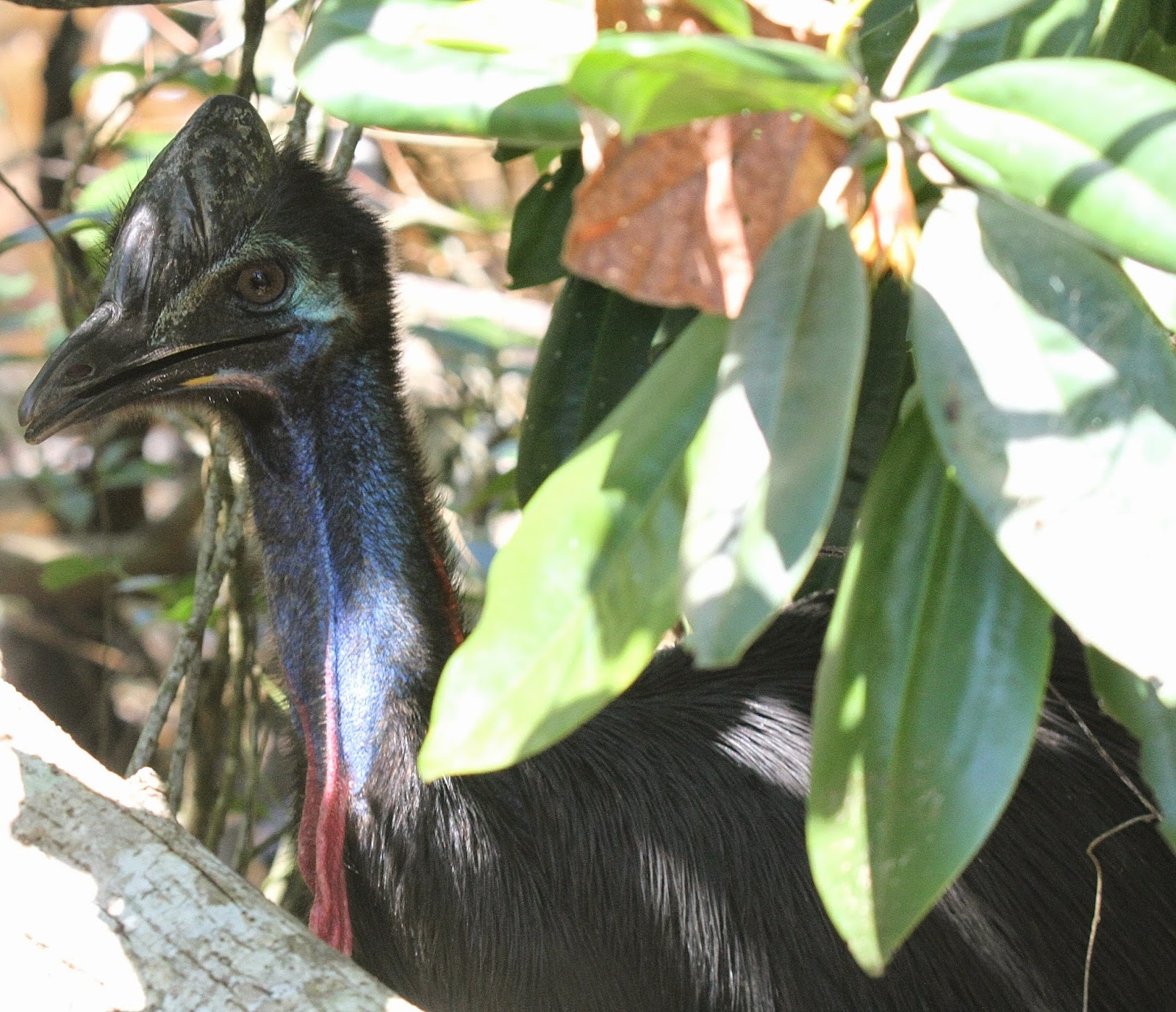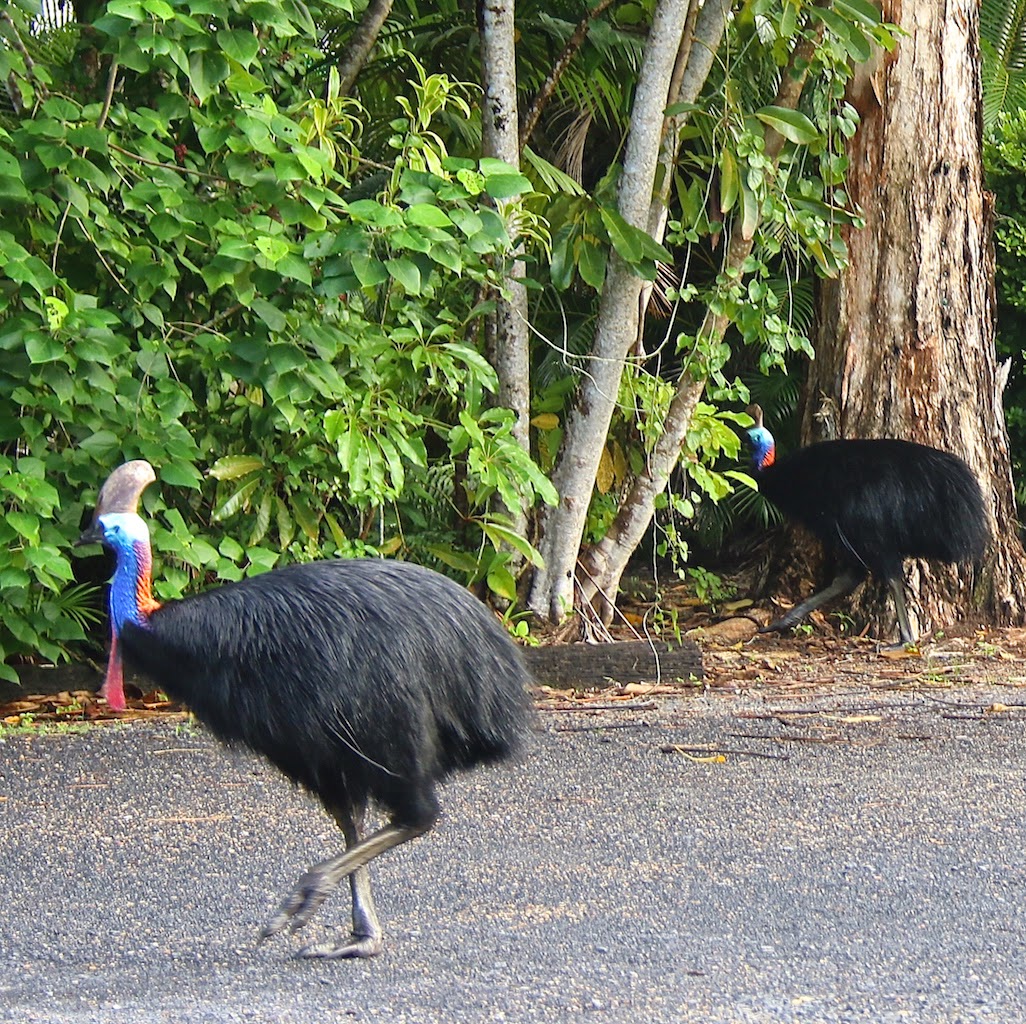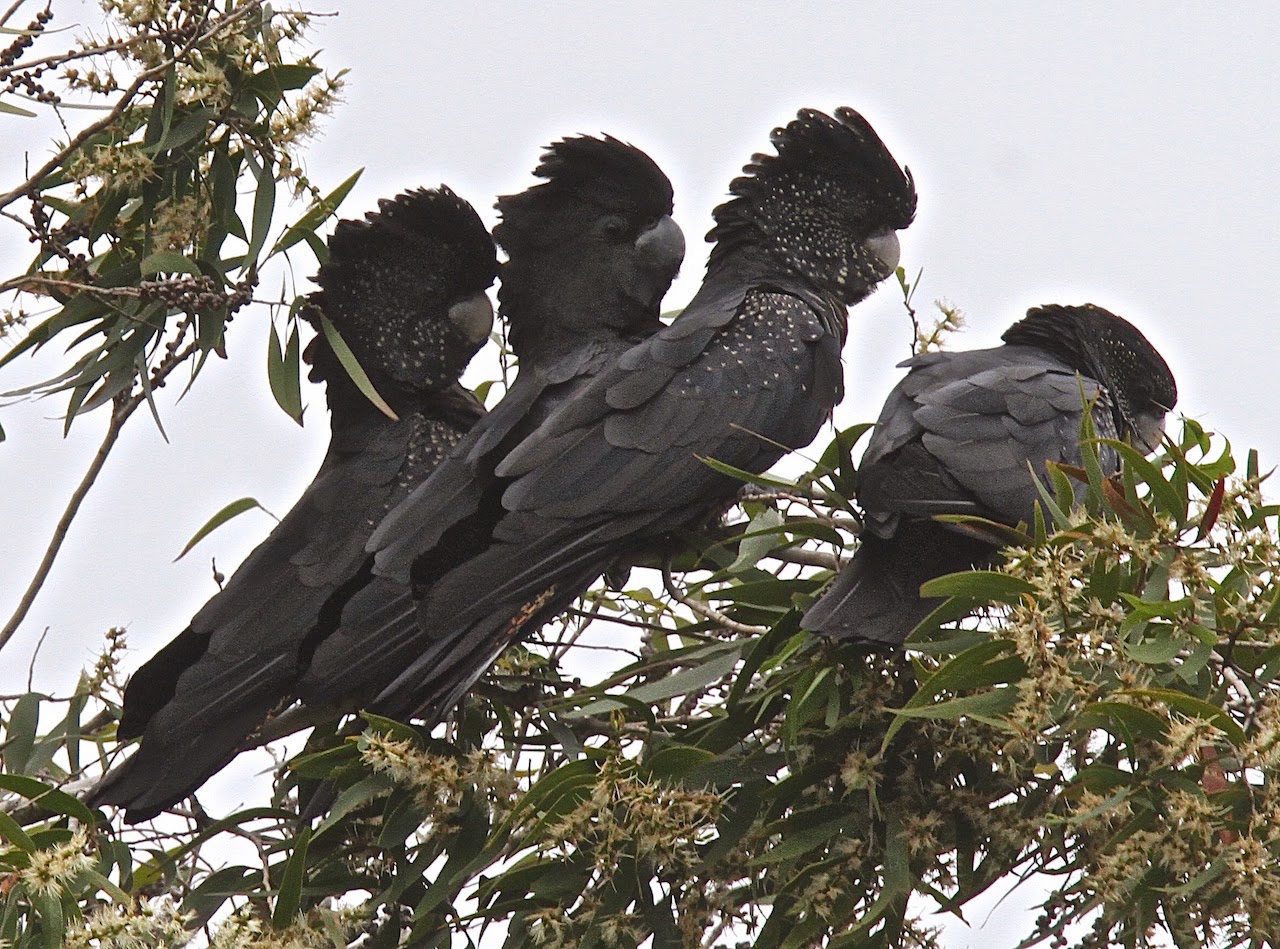This morning, as I did yesterday, I searched for cassowary Ky without finding him. On Thursday afternoon at 5.45 pm I received a phone call from a resident at the Coconuts, which is on the northern side of the Johnstone River Estuary, the caller told me she was watching two dogs attacking a large cassowary on the Coquette Point Spit. There were two men with sticks who were hitting the cassowary trying to stop it from hurting their dogs. The witness said the men were not trying to restrain the dogs but were hitting the cassowary. The dogs and the men were attacking the cassowary and there were two women with the men and they were watching. The caller begged me to try to help the cassowary.
I ran to the Spit from my house, about one kilometre. On the way, at the end of the road I saw three cars, one belonging to a fishermen known to me and I noted the number plates of the other cars. I ran out onto the spit but the cassowary, the dogs and the four people had left the site. The caller saw me on the spit and rang me again and told me she had watched the people involved in the cassowary incident and they had walked further along the beach with the dogs still running wild.
I followed the dog tracks and I met two women returning from a walk, they were carrying a dog. I spoke to them about the two signs that identify the area as World Heritage and a shore bird breeding site and how the two signs stated that no dogs were permitted in the area. The women said they did not see the signs. They were carrying their dog to protect it from the other dogs which were running wild, they said they did not witness the incident with the cassowary.

I continued to walk around to the front beach and I heard the wild barking of dogs coming from the Moresby Range National Park. I continued to walk to Thompson Point when I saw four people walking back along the beach. Behind the walkers I could still hear the dogs barking in the Moresby Range National Park but I could not see the dogs. The people kept walking and appeared uninterested in the whereabouts of their dogs or what animals the dogs were chasing.

 As I walked towards the people the dogs ran out of the Moresby Range National Park and barking loudly, they ran towards me.
As I walked towards the people the dogs ran out of the Moresby Range National Park and barking loudly, they ran towards me. The people made no attempt to restrain the dogs and when I called out for them to put the dogs on a lead one of the men walked towards me and started to shout abuse at me. Again, I asked him to put the dogs on a lead and I told him, very quietly, that this area is a no dog zone. He continued to shout abuse at me and got so close to my face I could smell his breathe. He told me, "Lady you have no # right to tell me what to # do. You # need to # find something to # keep you busy." I did not respond to his abuse and calmly told him a person had seen his dogs attack a cassowary and had seen him and his friend attack the cassowary with a stick. This enraged the man even more and he denied the incident and pointing his finger in my face, but not touching me, he shouted how he, after cyclone Yasi, had fed cassowaries at Flying Fish Point when the # authorities did # nothing. At this point I saw the dogs had run off and were chasing a bird on the beach. I again calmly told him to put the dogs on a lead. He told me there were no # cassowaries about, I told him the beach stone curlews were nesting above the dunes and the dogs might chase them. He then admitted that the dogs had chased the beach stone curlews earlier. The two women and the other man walked past us smiling and heckling. They did not appear to be at all concerned that their partner was shouting abuse at me.
When the man caught up with the others he called the dogs and put one dog on the one lead he was carrying. They were laughing and all appeared to think it was funny. They left the beach very quickly.
I started a search behind the spit for Ky but there was no sign of him. It was dark by the time I returned home.
I reported the incident to the wildlife hotline on 137468.
The next morning I was out at sunrise looking for Ky, but no sign of him. When I returned home I wrote a quick report to the Department of Environment and Heritage Protection, EHP, about the incident, then I continued to search for Ky. At low tide I went back to the site of the cassowary incident and photographed and measured the length of the cassowary footprint using a small stick. I was able to confirm from the size of the footprints, 21.5 cm, that it was Ky that was attacked by the dogs. Again, I searched behind the spit and in the mangroves but no sign of Ky, neither blood nor quills were on the sand.


At daylight this morning I searched the rainforest for Ky in all his known spots, I found no sign of him. Then at the midday low tide I walked into the mangroves along the boundary line of 27V and to my delight I found Ky.


Cassowary Ky was sitting in the water in the mangrove swamp. He turned around and looked at me then he stood up slowly and walked deeper into the mangroves, I did not follow, the area was impassable with cyclone debris.


As Ky walked away I noticed he had a low limp and walked very slowly as if in pain. I carefully looked through the lens of the camera to see if there were any wounds but I could seen none.

I walked out onto the spit and spoke to some fishermen in the area. Two of them told me they had seen Ky earlier and knew something was wrong with the cassowary as he would walk a few steps then sit down. I told them about the dog attack and they were all shocked and I asked them if they saw anyone with a dog on the beach to point out the signs and talk about the injured cassowary and other endangered species in the area. They all agreed to do so.


 Earlier this week Cassowary Ky was in the Melaleuca Swamp or on the beach and below are some of the photos I took of him over the week.
Earlier this week Cassowary Ky was in the Melaleuca Swamp or on the beach and below are some of the photos I took of him over the week.


Sometimes Ky would just stand looking across to the other side of the river. Other times I watched him walk all the way out as far as the sandbar was exposed. Somedays he walked up to the spit, the place where he was attacked on Thursday.


Cassowary Ky tried to make friends with reef egret and white faced heron but the birds weren't interested in him and they walked away.
Cassowary Ky's mum and dad were around again this week visiting the Ficus drupacea tree, strangler fig, which is in fruit. They did not hang about for long and once both cassowaries had a drink and a feed they disappeared back into the rainforest.

The other big excitement for the week was the capture of the elusive solitary wild boar of the Coquette Point herd.
I knew he was around from his footprints on the beach but he seldom walked onto the property, until last Sunday night. Monday morning the noise of him trying to get out of the cage could be heard from a mile away. I had recently purchased new Bungee cords for the pig cage and was confident the door would not open with the banging. He ran at the sides of the cage buckling the wire but the cage held. I called my neighbour John Wilson and he came down and shot the pig for me and was pleased to see this fella gone from Coquette Point as he had been doing a lot of damage.


I rang EHP, who use pig carcass to bait crocodile traps, they lifted the carcass into the back of their ute and took it away. The boar topped 100 kilograms.

The black cockatoos, fattened up on a diet of the aphrodisiac properties of the beach almond, Terminalia catappa, were well primed and this week have been engaged in mating in the tops of the tall paper-bark trees, Melaleuca leucadendra.
When once the red-tailed black cockatoo only visited the coast for a short harvest of the beach almond, now with the devastating drought in western Queensland they are making their home on the coast.
Passing through this week I saw the last of the migratory Cicadabirds. When I queried Del Richards about the bird's ID he told me it was a very dark example found along the coast. I have photographed the male and female cicadabirds here before but this one is the darkest form I have found.

A rare visitor on the beach this week was a very tall juvenile black necked stork. When I disturbed him he flew to the Spit but it was high tide and I could not follow. I have seen his footprints on the beach each day this week but missed seeing him again.

 Now the migratory waders have left darter, white-faced heron, eastern reef egret and striated heron have all returned to the estuary.
Now the migratory waders have left darter, white-faced heron, eastern reef egret and striated heron have all returned to the estuary.

As the sun sets over Coquette Point on ANZAC day 2015 I hope the survival of the natural world will be foremost in peoples' minds as we think about the Australia we wish to pass onto the next generation.
Yvonne.



















Wow, reading about those # people has made me so # angry. I absolutely cannot stand people who think that only some rules apply to them, especially where the environment is concerned. These people take it a step further though and actually willfully harm a magnificent creature.
ReplyDeleteI often see people with offleash dogs in nature reserves, always with clearly marked signs at the entrance advising against such activity. I'm hesitant to say something because as a six foot tall man, I tend to be #wit magnet for any angry person who's got something to prove. But you've inspired me to speak up Yvonne, I'll just keep it polite and firm.
That distant shot of the cassowary wandering the beach tugged at my heart-strings. Red-tailed BCs have turned up in decent sized flocks on the Sunshine Coast this month, perhaps fitting in with your drought theory also.
Hi Christian,
DeleteI find it very sad when people cannot see the intrinsic value of the natural world. Some people think it is their god-given right to destroy nature. Nature is fighting back and they will pay but unfortunately so will we all.
Please be careful when approaching people, far better to photograph them and put a report into the local authority. When speaking to anyone always put your camera on video and record the sound even if you don't get the picture.
Take care,
Yvonne
This comment has been removed by the author.
ReplyDelete
ReplyDeleteJean Ffrench25 April 2015 at 04:22
You are so brave to approach people with dogs! On behalf of vulnerable birds, thank you. Too many people think their dogs have the right to do whatever they want. Also congrats on getting the wild pig.
ReplyDelete
DeleteNo Jean I am not brave, just saddened by these people's actions, but I will be out their every day recording the gifts of the wonderful natural world which is all around us and if someone is breaking the law my camera will record that as well.
Yes my specially designed cassowary safe pig cage is keeping the feral pig population at Coquette Point under control. The boar I caught this week thought he was smart but I got him in the end, it just takes patiences and determination and I have years of experience at that.